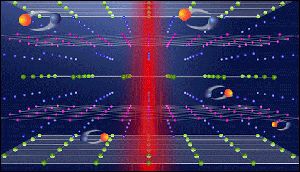New competing state of matter in superconducting material
4. 1. 2019 | Ames Laboratory | www.ameslab.gov
A team of experimentalists at the U.S. Department of Energy’s Ames Laboratory and theoreticians at University of Alabama Birmingham discovered a remarkably long-lived new state of matter in an iron pnictide superconductor, which reveals a laser-induced formation of collective behaviors that compete with superconductivity.
“Superconductivity is a strange state of matter, in which the pairing of electrons makes them move faster,” said Jigang Wang, Ames Laboratory physicist and Iowa State University professor. “One of the big problems we are trying to solve is how different states in a material compete for those electrons, and how to balance competition and cooperation to increase temperature at which a superconducting state emerges.”

To get a closer look, Wang and his team used laser pulses of less than a trillionth of a second in much the same way as flash photography, in order to take a series of snapshots. Called terahertz spectroscopy, this technique can be thought of as “laser strobe photography” where many quick images reveal the subtle movement of electron pairings inside the materials using long wavelength far-infrared light.
Read more at Ames Laboratory
Image Credit: Ames Laboratory
-jk-




